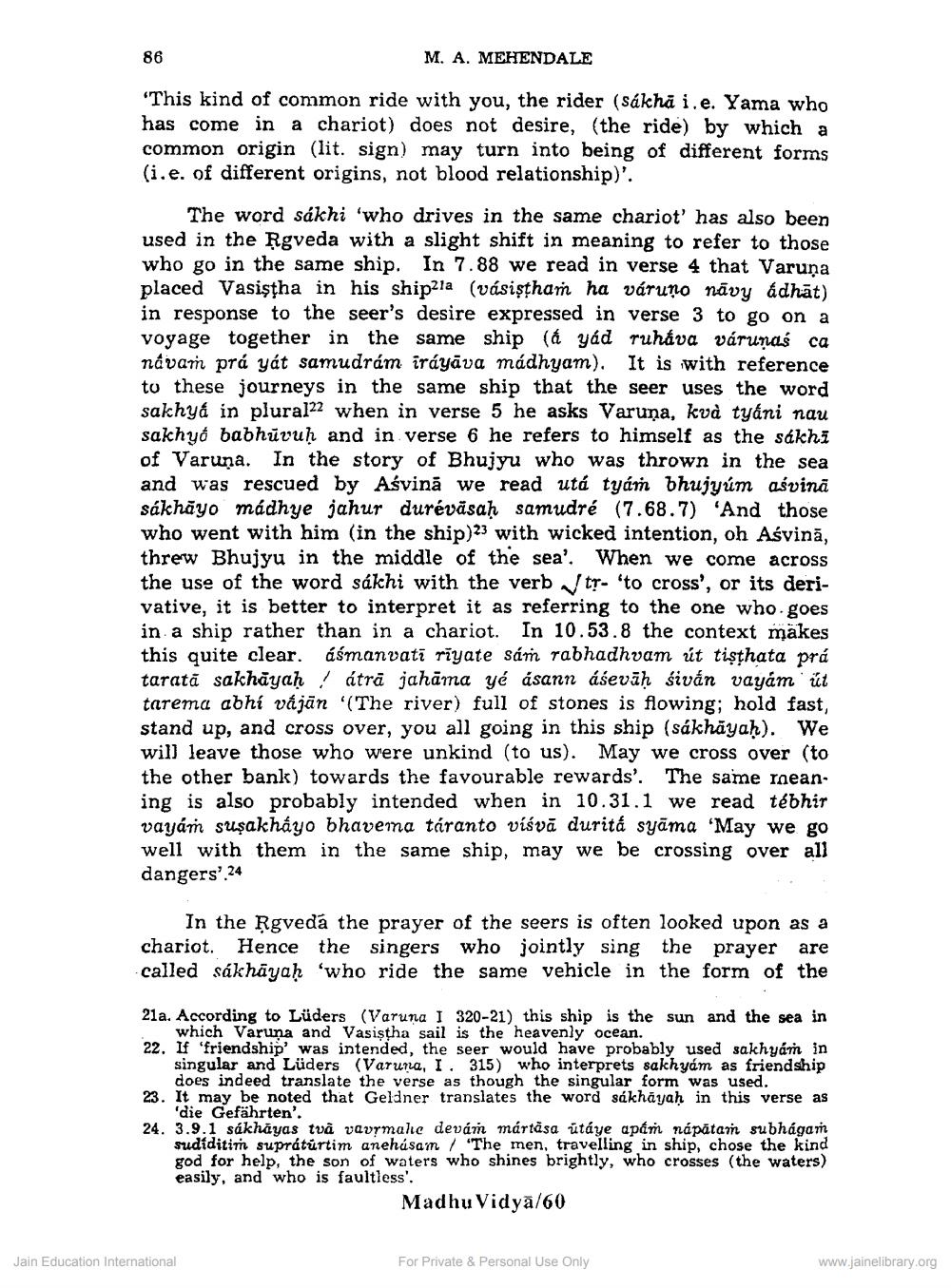________________
86
M. A. MEHENDALE
"This kind of common ride with you, the rider (sákhă i.e. Yama who has come in a chariot) does not desire, (the ride) by which a common origin (lit. sign) may turn into being of different forms (i.e. of different origins, not blood relationship)'.
The word sakhi 'who drives in the same chariot' has also been used in the Rgveda with a slight shift in meaning to refer to those who go in the same ship. In 7.88 we read in verse 4 that Varuna placed Vasiştha in his ship2la (vásişthan ha váruņo nāvy ádhāt) in response to the seer's desire expressed in verse 3 to go on a voyage together in the same ship (á yád ruháva várunaś ca návam prá yát samudrám iráyāva madhyam). It is with reference to these journeys in the same ship that the seer uses the word sakhya in plural22 when in verse 5 he asks Varuna, kvå tyáni nau sakhyo babhūvuḥ and in verse 6 he refers to himself as the sákhi of Varuna. In the story of Bhujyu who was thrown in the sea and was rescued by Aśvină we read utá tyám bhujyúm aśvinā sákhāyo madhye jahur durévasaḥ samudré (7.68.7) 'And those who went with him in the ship)23 with wicked intention, oh Aśvinā, threw Bhujyu in the middle of the sea'. When we come across the use of the word sákhi with the verb tr- 'to cross', or its derivative, it is better to interpret it as referring to the one who goes in a ship rather than in a chariot. In 10.53.8 the context makes this quite clear. áśmanvati riyate sám rabhadhvam út tişthata prá tarată sakhāyah! atrā jahāma yé ásann áśevāḥ śiván vayám út tarema abhí vậjān '(The river) full of stones is flowing; hold fast, stand up, and cross over, you all going in this ship (sákhāyah). We will leave those who were unkind (to us). May we cross over (to the other bank) towards the favourable rewards'. The same rnean. ing is also probably intended when in 10.31.1 we read tébhir vayam suşakháyo bhaverna táranto víśvā duritá syāma 'May we go well with them in the same ship, may we be crossing over all dangers'. 24
In the Rgveda the prayer of the seers is often looked upon as a chariot. Hence the singers who jointly sing the prayer are called sákhāyaḥ 'who ride the same vehicle in the form of the
ride the comJointly sing the ed upon as a
23.
21a. According to Lüders (Varuna I 320-21) this ship is the sun and the sea in
which Varuna and Vasiştha sail is the heavenly ocean. 22. If 'friendship' was intended, the seer would have probably used sakhyán in
singular and Lüders (Varuna, I. 315) who interprets sakhyám as friendship does indeed translate the verse as though the singular form was used. It may be noted that Geldner translates the word sakhāyaḥ in this verse as
'die Gefährten'. 24. 3.9.1 sákhāyas två vaurmahe deván mártása utáye apan nápātam subhagam
sudiditin suprátúrtim anehúsam / 'The men, travelling in ship, chose the kind god for help, the son of waters who shines brightly, who crosses (the waters) easily, and who is faultless'.
Madhu Vidyā/60
Jain Education International
For Private & Personal Use Only
www.jainelibrary.org




